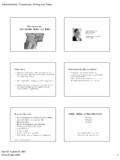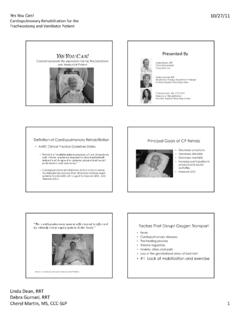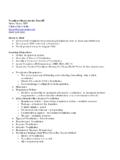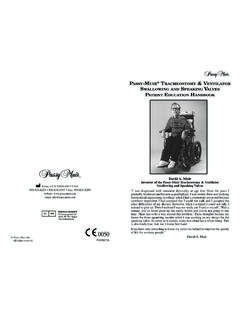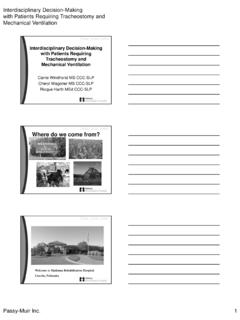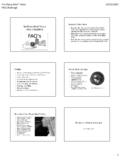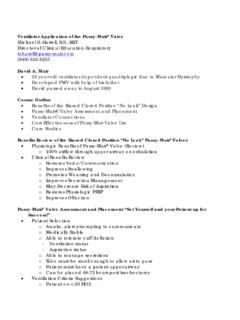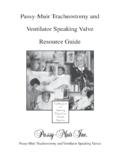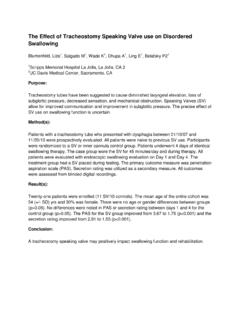Transcription of Swallow Function: Passy-Muir Valve Use for …
1 Swallow Function: Passy-Muir Valve Use for evaluation & rehabilitation mary spremulli , MA, CCC-SLP Passy-Muir Clinical Consultant (949) 833-8255 David A. muir 23 year-old ventilator dependent quadriplegic due to Muscular Dystrophy Developed PMV with help of his father David passed away in August 1990 Course Outline Physiology of Swallow Aspiration Risks Tracheostomy Tubes and Swallow The Passy-Muir valves Benefits of the Passy-Muir valves Troubleshooting and Treatment Planning Physiology of Swallow The Aerodigestive Tract Is a Shared System o Respiratory system shares a common functional space with the digestive tract and the vocal tract.
2 O The trachea is a dynamic structure o We never fully exhale ( physiological PEEP) o The Upper-Aerodigestive Tract Is a Valving System o Beginning at the lips and ending at the UES, the valves are always permitting or preventing airflow, food, or liquids to go from one direction to another. Consensus o High incidence of disordered swallowing following intubation, tracheostomy, and mechanical ventilation Oral Preparatory and Oral Stage Swallowing o Readiness to accept the bolus, including level of alertness. o Positioning, dentition, and medications. o Valving system: lip closure, lingual propulsion, velopharyngeal closure.
3 Pharyngeal Stage of Swallowing o Hyo-laryngeal anterior motion provides some airway protection and opens UES sphincter o Bolus pressure widens opening of UES o Closure of the laryngeal valving system. Respiratory Pause o In healthy adults there is a respiratory pause during the Swallow , with swallowing occurring most often in mid-expiration o There is evidence that swallows occurring at lower lung volumes such as exhalation to inhalation transition are more likely to result in aspiration Esophageal Phase of Swallowing o Readiness to accept the bolus, including level of alertness.
4 O Positioning, dentition, and medications. o Valving system: lip closure, lingual propulsion, velopharyngeal closure. o Reflexive phase transports the bolus via persistaltic wave. Aspiration Risks Effects of Tracheostomy on Normal Swallowing Function o Tracheostomy is often preceded by endotracheal tube intubation. (oral or nasal) Well Documented Complications Associated with Endotracheal Tubes o Mucosal injury o Blunting of glottic reflexes o Allows free passage (aspiration) of oral-pharyngeal secretions into the upper airway with a heightened risk for Ventilator Associated Pneumonia (VAP) Aspiration Pneumonia Is an Opportunistic Infection o Something must be aspirated.
5 O Aspirate must contain a respiratory pathogen. o Must be able to overwhelm patient s normal defense/immune system. Additional Identified Risk Factors Predisposing Patients to Aspiration Include: o Witnessed aspiration secondary to emesis or reflux. o Supine position and coma. o Enteral nutrition and presence of a nasogastric tube. o Multiple intubations or self-extubation. Aspiration o Incidence of aspiration in patients with tracheostomy is estimated to be in the range of 50-83% (includes silent aspiration ) o Is this a causal relationship? o Other factors cited to contribute: intubation and underlying critical illness Additional Identified Risk Factors Predisposing Patients to Aspiration Include: o COPD, age > 60 years, and acute respiratory distress syndrome o Prior exposure to antibiotics which predispose the patient to colonization of the upper aerodigestive tract.
6 O Infection control lapses, including hand washing and non-sterile tracheal suctioning Ventilator Associated Pneumonia (VAP) o Defined as nosocomial (hospital acquired) pneumonia occurring in patients after 48 hours of mechanical ventilation via endotracheal tube or tracheostomy tube o Oral-pharyngeal secretions colonized with bacteria bypass the cuff on the ET tube or tracheostotmy tube and pass into the lower respiratory tract. Factors Related to Dysphagia Which May Influence Cost of Care for Tracheostomized Patients: o Pulmonary complications from aspiration, use of antibiotics, reduced weaning, and prolonged ICU/hospital stay.
7 O Late onset aspiration due to undiagnosed laryngeal injury or impairment. o Depression and reduced patient participation in care, reduced quality of life and impaired communication and loss of control over decision making. Tracheostomy Tubes and Swallow Early Tracheostomy (7-10 days) May: o Reduce incidence of VAP and further injury to the larynx caused by the ET tube. o Improve patient comfort including possibility for oral communication and oral diet and requirement for less sedation o Improve oral hygiene o Improve secretion management (pulmonary toilet) Indications for Tracheostomy o Upper airway obstruction o Pulmonary toilet o Mechanical ventilation A Tracheostomy Alters Physiological Function of Upper AeroDigestive Tract o Aphonia o Reduced ability to expectorate secretions o Reduced sense of taste and smell o Reduced physiological PEEP o Reduced ability to expectorate secretions Tracheostomy Effect on Swallowing.
8 O Scar tissue formation from the tracheotomy procedure may affix the trachea to overlying tissues and the larynx may not move freely o If the tube is too large for the patient s trachea, patient may feel discomfort and may compensate with reduced laryngeal excursion o Many physicians conceive of a tracheostomy as a solution to long term aspiration, but in reality, it may increase the problem rather than solve it. Nash, 1998 The Cuff on the Tracheostomy Tube Is Indicated During Mechanical Ventilation o The cuff is designed to create a closed system, so the volume of air delivered to the lungs is not lost due to an upper airway leak.
9 O The cuff may reduce the impact of aspiration, but cannot prevent aspiration, it sits below the level of the true vocal folds. Aspiration of Liquid or Food Around the Tracheostomy Tube Cuff Has Been Well Documented o The tracheal lumen is not static during respiration. o Aspiration around the tracheal cuff may be due to the leak caused by tracheal dilation during inspiration, and/or due to secretions which pool above the cuff. o The cuff may create a reservoir for pooled or stagnate secretions to colonize and eventually enter the lower respiratory tract. Cuff Mismanagement Has Been Associated with: o Damage to the tracheal mucosa o Tracheal stenosis o Granulation formation o Tracheal erosion o Tracheoesophageal fistula o Tracheal dilation Mismanagement of Cuff Pressures o Distention caused by the cuffed tracheostomy tube against the esophagus may cause liquids to overflow the UES and fall into the trachea.
10 O Refluxed tube feedings or gastric contents may also enter the airway via the same mechanism Tracheostomy Tube Effect on Swallowing o Impaired oral-pharyngeal pressure o Impaired hyolaryngeal elevation/excursion o Impaired glottic closure o Reduced subglottic pressures and reduced o Muscle disuse atrophy Effect of Mechanical Ventilation on Swallowing: o Ventilator modes with a pre-set breath may push air at a time the patient is trying to maintain airway closure for a Swallow . o If the cuff is deflated, without a Passy-Muir Valve , a translaryngeal leak may occur on inspiration and expiration.
